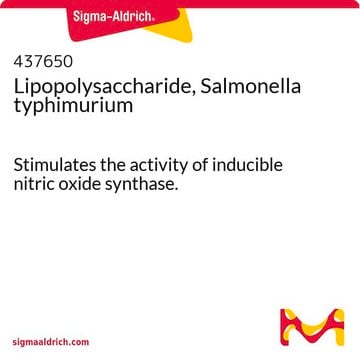SMB00610
Lipopolysaccharide from Porphyromonas gingivalis
purified by phenol extraction
Sinonimo/i:
LPS
About This Item
Prodotti consigliati
Origine biologica
Porphyromonas gingivalis
Livello qualitativo
Forma fisica
powder
Purificato mediante
phenol extraction
Impurezze
≤3% Protein (Lowry)
Colore
white to faint yellow
Solubilità
triethylene glycol dimethyl ether: 0.90-1.10 mg/mL to hazy, colorless to light yellow
Condizioni di spedizione
ambient
Temperatura di conservazione
2-8°C
Categorie correlate
Descrizione generale
Applicazioni
- as a treatment to stimulate acute lung injury in human bronchial epithelial (HBE) cells
- as an agonist for toll-like receptor 4 (TLR4) and to stimulate intestinal normal fibroblasts (NFs) to study osteopontin (OPN) expression in myofibroblasts
- to study its effects on pro-inflammatory and pro-coagulant genes expression in endothelial cells
Azioni biochim/fisiol
Additionally, it was demonstrated that the mechanisms by which LPS from E. coli and P. gingivalis modulate cluster of differentiation 14 (CD14), toll-like receptor 2 (TLR2), and toll-like receptor 4 (TLR4) surface expression, primary and secondary cytokine responses are different.
Porphyromonas gingivalis is a Gram-negative bacterium that is known to be involved in adult periodontitis. Periodontitis is a chronic inflammatory disease characterized by the recession of the supportive tissue surrounding teeth. Studies have shown that the LPS from P. gingivalis plays an important role in this disease.
A recent study demonstrated that LPS from P. gingivalis stimulates insulin secretion by the pancreatic β cell line, MIN6. In the presence of 5 mM glucose and 50-500 ng/mL LPS from P. gingivalis, a significant induction of insulin secretion was observed.
Nota sulla preparazione
Altre note
Codice della classe di stoccaggio
11 - Combustible Solids
Classe di pericolosità dell'acqua (WGK)
WGK 3
Punto d’infiammabilità (°F)
Not applicable
Punto d’infiammabilità (°C)
Not applicable
Certificati d'analisi (COA)
Cerca il Certificati d'analisi (COA) digitando il numero di lotto/batch corrispondente. I numeri di lotto o di batch sono stampati sull'etichetta dei prodotti dopo la parola ‘Lotto’ o ‘Batch’.
Possiedi già questo prodotto?
I documenti relativi ai prodotti acquistati recentemente sono disponibili nell’Archivio dei documenti.
I clienti hanno visto anche
Articoli
Explore the structure, function, and diverse applications of Lipopolysaccharides. Discover their role in bacteria, serological specificity, and research potential.
Il team dei nostri ricercatori vanta grande esperienza in tutte le aree della ricerca quali Life Science, scienza dei materiali, sintesi chimica, cromatografia, discipline analitiche, ecc..
Contatta l'Assistenza Tecnica.



